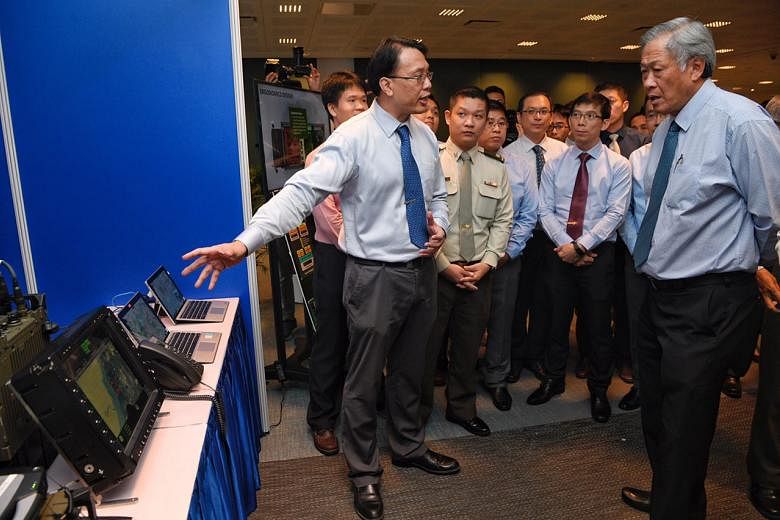SINGAPORE - Rather than communicate through voice on a radio system on the battlefield, Singapore Armed Forces (SAF) soldiers can now indicate an enemy's location by tapping it on a map on a smartphone.
Photos and videos can also be sent to command posts away from the frontline, so that commanders can better assess the ground situation and call for reinforcements if necessary.
The Secure Army Battlefield Internet (ABI), which is a network system that streamlines communication across SAF services like army to air force, features a real-time map developed to suit battlefield conditions where critical network infrastructure may be destroyed.
The ABI will allow different units deployed in different locations to share information quickly, accurately and securely.
The joint project between Defence Science and Technology Agency (DSTA), DSO National Laboratories, the Singapore Army and ST Electronics were one of the five team winners of the annual Defence Technology Prize on Friday (Oct 20), the most prestigious defence technology award given by Mindef. There were two individual winners.
With the trooper on the battlefield hooked up to the same internet as their commanders, there is reduced latency and less room for human errors, such as passing down instructions inaccurately, said team leader Hee Yong Siong, 44, who is the head information for innovation (land systems) at Defence Science and Technology Agency (DSTA).
"The ABI (also) allows communications digitally from ground to air seamlessly, to enhance coordination of air-land operations. With timely and precise air support, warfighting on the ground can achieve a higher level of effectiveness," he added.
A theme of this year's award winners is the focus on information superiority, said Mindef's chief defence scientist Quek Gim Pew, who chaired the judging panel.
He said this year's projects showed that the efforts of the SAF to transform itself into a third-generation fighting force over the past 10 to 15 years is coming to fruition.
Defence Minister Ng Eng Hen gave out the awards at the ceremony held at the DSO National Laboratories at Kent Ridge.
In his speech, Dr Ng commended the work of the defence technology community.
He also talked about recent efforts to attract more engineering talent, such as the Public Service Commission Scholarship (Engineering) for Defence and Security introduced this year. Four received the scholarship in July.
Dr Ng said then that the need for field commanders to work with engineers and scientists to manage the expected reduction in SAF's manpower was the reason behind the new scholarship.
On Friday, Dr Ng said: "I think this is something that we can be proud of, that the defence technology community within Singapore - DSTA, DSO and ST companies - are respected for their expertise and professionalism."
Another team from DSO National Laboratories also won an engineering award for developing an air surveillance system that is able to detect both commercial and non-commercial drones as small as one that can almost fit into a person's palm.
Not only would the system help to prevent accidental collisions by hobbyists' drones into key installations such as military bases and main government buildings, it is also crucial to stop those with malicious intent from carrying cameras and explosives into these sensitive areas, said team lead Tay Poh Kok, 49, who is a programme manager at DSO.
The team of about 20 from DSO worked with DSTA and the Republic of Singapore Air Force to develop the technology, which can be scaled to meet the size of the area to be surveilled and is now ready to be operationalised.


